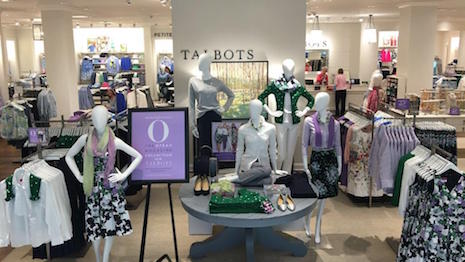 Getting mobile in-store
Getting mobile in-store
While consumers are now armed with a throng of technology devices and experiences, organizations within retailers’ businesses create a series of red tape, preventing a true omnichannel experience that is needed in today’s market.
According to BRP’s Merchandise Planning Survey, luxury brands and retailers are not equipped to provide the all around experience consumers are looking for in today’s on-demand market, with 71 percent retailers lacking a formal omnichannel process. While 44 percent of retailer’s do have integrated planning teams, more than 86 percent are in dire need of improvement.
“Most retailers know that their current planning tools are not capable of supporting today’s omnichannel environment but they are not able to get the necessary budget allocations to update their planning applications,” said Gene Bornac, vice president at BRP. “Retailers are focusing on upgrading their customer-facing touch points such as point of sale, ecommerce and mobile, and ignoring the planning applications needed to support them.
“This was really a surprise outcome of this survey,” he said. “The good news is that there are a number of very good tools available to address current planning needs, but the challenge will remain to get the budget and resource commitments to upgrade systems.”
Omnichannel improvement
Bricks-and-mortar is still being thought of as a separate channel within retail businesses, which is a severe hindrance. Consumers do not think in terms of channels and interact with brands sporadically throughout different channels at random times.
 Image courtesy of InstantLuxe
However, about 38 percent retailers think of bricks-and-mortar as a completely separate entity, but 41 percent hope to upgrade their omnichannel planning systems by the end of 2018.
Many retailers have even acknowledge the lack of integration issue, as 21 percent of retailers claiming that process issues and disparate systems are the barriers in terms of planning.
Image courtesy of InstantLuxe
However, about 38 percent retailers think of bricks-and-mortar as a completely separate entity, but 41 percent hope to upgrade their omnichannel planning systems by the end of 2018.
Many retailers have even acknowledge the lack of integration issue, as 21 percent of retailers claiming that process issues and disparate systems are the barriers in terms of planning.
 Image courtesy of Rolls-Royce
Seventy-five percent of retailers of the 63 percent that do have an integrated planning system across channels claim to need improvement. About 70 percent have similar processes but within business across channels, however almost 83 percent still need improvement.
Retailer research
Another important thing to note for retailers is that while Singles' Day catches the eye of most luxury retailers rather than Black Friday deals, those that continue to skip the discount-focused day will miss out, as even affluent consumers still appreciate a good deal.
A recent survey from Deloitte has shown that consumers are planning on spending more this Thanksgiving compared to last year, with more than 76 percent of Americans planning to shop over the Black Friday weekend. Many luxury brands are finally taking the leap to incorporate a strategy for the major sales day such as Prada, Omega and Gucci, who are partnering with Walmart.com to feature heavily discounted luxury goods online over the weekend (see more).
Despite the overall boom in mobile transactions, a new report finds that its growth is not yet optimal due to inefficiencies in checkout and payment tracks.
The report, published by business intelligence firm L2, sheds light on the state of mobile transactions by surveying a variety of metrics including transaction impetus, expedited payment options and conversion rates. The resulting data is rich in insight for brands that are looking to optimize their mobile-based sales in a high-impact yet organic fashion (see more).
“Most retailers know that their current planning tools are not capable of supporting today’s omni-channel environment but they aren’t able to get the necessary budget allocations to update their planning applications,” Boston Retail Partners' Mr. Bornac said. “Retailers are focusing on upgrading their customer-facing touch points such as point of sale, ecommerce and mobile, and ignoring the planning applications needed to support them.
“This was really a surprise outcome of this survey,” he said. “The good news is that there are a number of very good tools available to address current planning needs, but the challenge will remain to get the budget and resource commitments to upgrade systems.”
Image courtesy of Rolls-Royce
Seventy-five percent of retailers of the 63 percent that do have an integrated planning system across channels claim to need improvement. About 70 percent have similar processes but within business across channels, however almost 83 percent still need improvement.
Retailer research
Another important thing to note for retailers is that while Singles' Day catches the eye of most luxury retailers rather than Black Friday deals, those that continue to skip the discount-focused day will miss out, as even affluent consumers still appreciate a good deal.
A recent survey from Deloitte has shown that consumers are planning on spending more this Thanksgiving compared to last year, with more than 76 percent of Americans planning to shop over the Black Friday weekend. Many luxury brands are finally taking the leap to incorporate a strategy for the major sales day such as Prada, Omega and Gucci, who are partnering with Walmart.com to feature heavily discounted luxury goods online over the weekend (see more).
Despite the overall boom in mobile transactions, a new report finds that its growth is not yet optimal due to inefficiencies in checkout and payment tracks.
The report, published by business intelligence firm L2, sheds light on the state of mobile transactions by surveying a variety of metrics including transaction impetus, expedited payment options and conversion rates. The resulting data is rich in insight for brands that are looking to optimize their mobile-based sales in a high-impact yet organic fashion (see more).
“Most retailers know that their current planning tools are not capable of supporting today’s omni-channel environment but they aren’t able to get the necessary budget allocations to update their planning applications,” Boston Retail Partners' Mr. Bornac said. “Retailers are focusing on upgrading their customer-facing touch points such as point of sale, ecommerce and mobile, and ignoring the planning applications needed to support them.
“This was really a surprise outcome of this survey,” he said. “The good news is that there are a number of very good tools available to address current planning needs, but the challenge will remain to get the budget and resource commitments to upgrade systems.”
